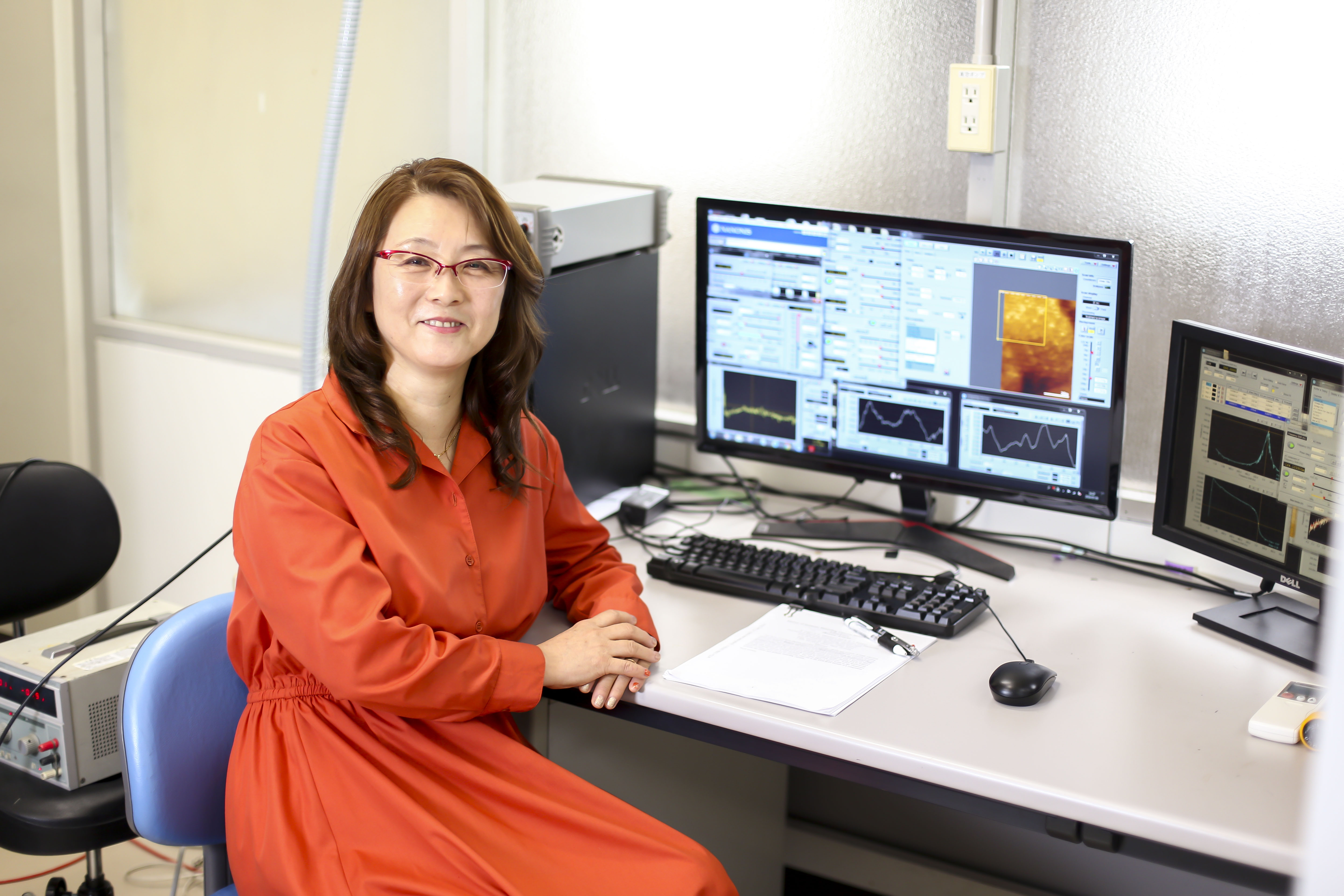
Dr. Yanjun Li, Associate Professor, Department of Applied Physics, Graduate School of Engineering
"A novel method - Put a new spin on molecular oxygen"
An article by Dr. Yanjun Li entitled “Tip-induced control of charge and molecular bonding of oxygen atoms on the rutile TiO2 (110) surface with atomic force microscopy,” was recently published in ACS Nano. A multinational team led by Dr. Li uses experimental Kelvin probe force spectroscopy to alter the charge states on single oxygen atoms and achieve reversible conversion of oxygen atoms to molecular oxygen.
Herself a veteran of international collaboration, she promotes it in her lab
Born in Beijing, China, Dr. Li came to Japan in 1994 after 5 years of teaching at Beijing Architectural and Civil Engineering Institute. She received her doctorate in Engineering in 2001 from the University of Tsukuba, after which she worked at the Institute for Molecular Science of the Okazaki National Research Institutes as a research fellow from 2001 to 2004 and took a position at Osaka University. She served as one of 100 experts in China’s Shanxi province and as a Professor at North University of China before taking her current position at the Department of Applied Physics, Graduate School of Engineering. Her research group has 6 Japanese students and 6 international students and is welcoming of young students and researchers, especially those who are interested in nanoscience and nanotechnology.
Her research involves using various forms of scanning probe microscopy (SPM), such as atomic force microscopy (AFM) and Kelvin probe force microscopy (KPFM), to investigate physical and chemical properties and explore and elucidate new physical phenomena on solid surfaces. Her group is working to elucidate the mechanisms of catalytic reactions on noble metal-supported metal oxide surfaces at the atomic level. Their first target is Pd nanoparticles (NPs) deposited on an Al2O3 /NiAl(110) surface in the presence of carbon monoxide (CO) gas, while their second target is Au NPs deposited on a rutile TiO2 (110) surface in gaseous environments at low temperatures.
Making deep discoveries in surface-level chemical research
Recently, for the first time, the charge states of adsorbed oxygen adatoms on the rutile TiO2 (110)-(1×1) surface were successfully measured and deliberately manipulated by non-contact AFM and KPFM at 78 K and interpreted by extensive density functional theory modeling. Several kinds of single and double oxygen adatom species are clearly distinguished and assigned to three different charge states: Oad− /2Oad− , Oad2− /2Oad2− and Oad−−Oad2− (Experiment was contributed by student Quanzhen Zhang). In addition, Dr. Li’s group managed to reversibly switch the charge states of the oxygen adatoms between the Oad− and Oad2− states, both individually and next to another oxygen, by modulating the frequency shift at constant positive voltage during both charging and discharging processes. This work provides a novel route for the investigation of the charge state of the adsorbates and opens up novel prospects for studying transition-metal-oxide-based catalytic reactions. Dr. Li’s group also studies the on-surface reversible chemical reaction of oxygen atoms to molecules. The reaction is activated by charge transfer from two sources, natural surface/subsurface polarons and experimental KPFM as a tool for electronic charge manipulation with single electron precision. These results were published in JACS and ACS NANO at https://pubs.acs.org/doi/10.1021/acsnano.9b01792.

Fig. Reversible chemical reaction of oxygen atoms to molecule.
Taking International Collaboration to the Next Level
Dr. Li has initiated a number of international collaborations and is currently organizing four joint laboratories with King’s College London, Slovak Academy of Science, Chinese Academy of Science/National Center for Nanoscience and Technology, and North University of China.
Dr. Li says, “International research collaboration not only provides for communication between well-known international researchers and researchers at Osaka University, but it also promotes the development of presentation skills in English. It’s also the best opportunity for us to get young researchers and excellent students from overseas to join our lab. We anticipate even more international research collaboration in the form of a joint laboratory, while also dispatching young researchers to overseas research institutions.”

Text: Saori Obayashi/Edit: Christopher Bubb